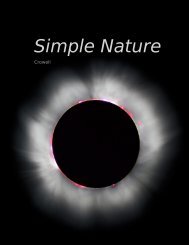Chapter 3 Acceleration and free fall - Light and Matter
Chapter 3 Acceleration and free fall - Light and Matter
Chapter 3 Acceleration and free fall - Light and Matter
You also want an ePaper? Increase the reach of your titles
YUMPU automatically turns print PDFs into web optimized ePapers that Google loves.
138 <strong>Chapter</strong> 4 Force <strong>and</strong> motion<br />
up 100 joules per second of energy. When you sit in a chair, no energy<br />
is used up, so forces can exist between you <strong>and</strong> the chair without any<br />
need for a source of power.<br />
4. Force is not stored or used up.<br />
Because energy can be stored <strong>and</strong> used up, people think force<br />
also can be stored or used up.<br />
Incorrect statement: “If you don’t fill up your tank with gas, you’ll run<br />
out of force.”<br />
Energy is what you’ll run out of, not force.<br />
5. Forces need not be exerted by living things or machines.<br />
Transforming energy from one form into another usually requires<br />
some kind of living or mechanical mechanism. The concept is not<br />
applicable to forces, which are an interaction between objects, not<br />
a thing to be transferred or transformed.<br />
Incorrect statement: “How can a wooden bench be making an upward<br />
force on my rear end? It doesn’t have any springs or anything inside it.”<br />
No springs or other internal mechanisms are required. If the bench<br />
didn’t make any force on you, you would obey Newton’s second law <strong>and</strong><br />
<strong>fall</strong> through it. Evidently it does make a force on you!<br />
6. A force is the direct cause of a change in motion.<br />
I can click a remote control to make my garage door change from<br />
being at rest to being in motion. My finger’s force on the button,<br />
however, was not the force that acted on the door. When we speak<br />
of a force on an object in physics, we are talking about a force that<br />
acts directly. Similarly, when you pull a reluctant dog along by its<br />
leash, the leash <strong>and</strong> the dog are making forces on each other, not<br />
your h<strong>and</strong> <strong>and</strong> the dog. The dog is not even touching your h<strong>and</strong>.<br />
self-check B<br />
Which of the following things can be correctly described in terms of<br />
force?<br />
(1) A nuclear submarine is charging ahead at full steam.<br />
(2) A nuclear submarine’s propellers spin in the water.<br />
(3) A nuclear submarine needs to refuel its reactor periodically. ⊲<br />
Answer, p. 538<br />
Discussion questions<br />
A Criticize the following incorrect statement: “If you shove a book<br />
across a table, friction takes away more <strong>and</strong> more of its force, until finally<br />
it stops.”<br />
B You hit a tennis ball against a wall. Explain any <strong>and</strong> all incorrect<br />
ideas in the following description of the physics involved: “The ball gets<br />
some force from you when you hit it, <strong>and</strong> when it hits the wall, it loses part<br />
of that force, so it doesn’t bounce back as fast. The muscles in your arm<br />
are the only things that a force can come from.”














